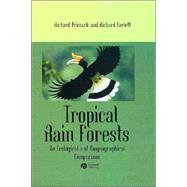
Richard Corlett, an associate professor at the University of Hong Kong, has studied tropical forests in New Guinea, Southeast Asia, and southern China. His major current research interest is in how rainforest plants and animals survive in human-dominated landscapes. He has previously taught ecology at the University of Chiang Mai, in Thailand, and at the National University of Singapore, and is co-author of books on the ecology of Singapore and Hong Kong.
| Preface, | viii | ||||
| Acknowledgments, | x | ||||
| 1 Many Tropical Rain Forests, | 1 | (29) | |||
|
3 | (1) | |||
|
4 | (4) | |||
|
8 | (9) | |||
|
17 | (7) | |||
|
24 | (3) | |||
|
27 | (2) | |||
|
29 | (1) | |||
|
29 | (1) | |||
| 2 Plants: Building Blocks of the Rain Forest, | 30 | (45) | |||
|
32 | (1) | |||
|
33 | (1) | |||
|
34 | (3) | |||
|
37 | (14) | |||
|
51 | (6) | |||
|
57 | (8) | |||
|
65 | (1) | |||
|
66 | (4) | |||
|
70 | (1) | |||
|
71 | (3) | |||
|
74 | (1) | |||
| 3 Primate Communities: a Key to Understanding Biogeography and Ecology, | 75 | (23) | |||
|
75 | (1) | |||
|
76 | (5) | |||
|
81 | (1) | |||
|
82 | (3) | |||
|
85 | (9) | |||
|
94 | (1) | |||
|
95 | (2) | |||
|
97 | (1) | |||
| 4 Carnivores and Plant-eaters, | 98 | (35) | |||
|
98 | (13) | |||
|
111 | (18) | |||
|
129 | (2) | |||
|
131 | (2) | |||
| 5 Birds: Linkages in the Rain Forest Community, | 133 | (45) | |||
|
134 | (5) | |||
|
139 | (4) | |||
|
143 | (11) | |||
|
154 | (1) | |||
|
155 | (5) | |||
|
160 | (5) | |||
|
165 | (2) | |||
|
167 | (2) | |||
|
169 | (1) | |||
|
170 | (2) | |||
|
172 | (1) | |||
|
173 | (3) | |||
|
176 | (1) | |||
|
177 | (1) | |||
| 6 Fruit Bats and Gliding Animals in the Tree Canopy, | 178 | (20) | |||
|
178 | (3) | |||
|
181 | (2) | |||
|
183 | (1) | |||
|
184 | (3) | |||
|
187 | (1) | |||
|
188 | (1) | |||
|
189 | (6) | |||
|
195 | (2) | |||
|
197 | (1) | |||
| 7 Insects: Diverse, Abundant, and Ecologically Important, | 198 | (35) | |||
|
199 | (7) | |||
|
206 | (12) | |||
|
218 | (4) | |||
|
222 | (1) | |||
|
223 | (7) | |||
|
230 | (2) | |||
|
232 | (1) | |||
| 8 The Future of Rain Forests, | 233 | (49) | |||
|
233 | (8) | |||
|
241 | (13) | |||
|
254 | (6) | |||
|
260 | (3) | |||
|
263 | (3) | |||
|
266 | (1) | |||
|
267 | (11) | |||
|
278 | (3) | |||
|
281 | (1) | |||
| References, | 282 | (25) | |||
| Index, | 307 |
The New copy of this book will include any supplemental materials advertised. Please check the title of the book to determine if it should include any access cards, study guides, lab manuals, CDs, etc.
The Used, Rental and eBook copies of this book are not guaranteed to include any supplemental materials. Typically, only the book itself is included. This is true even if the title states it includes any access cards, study guides, lab manuals, CDs, etc.